Viticulture Essentials Edition Review
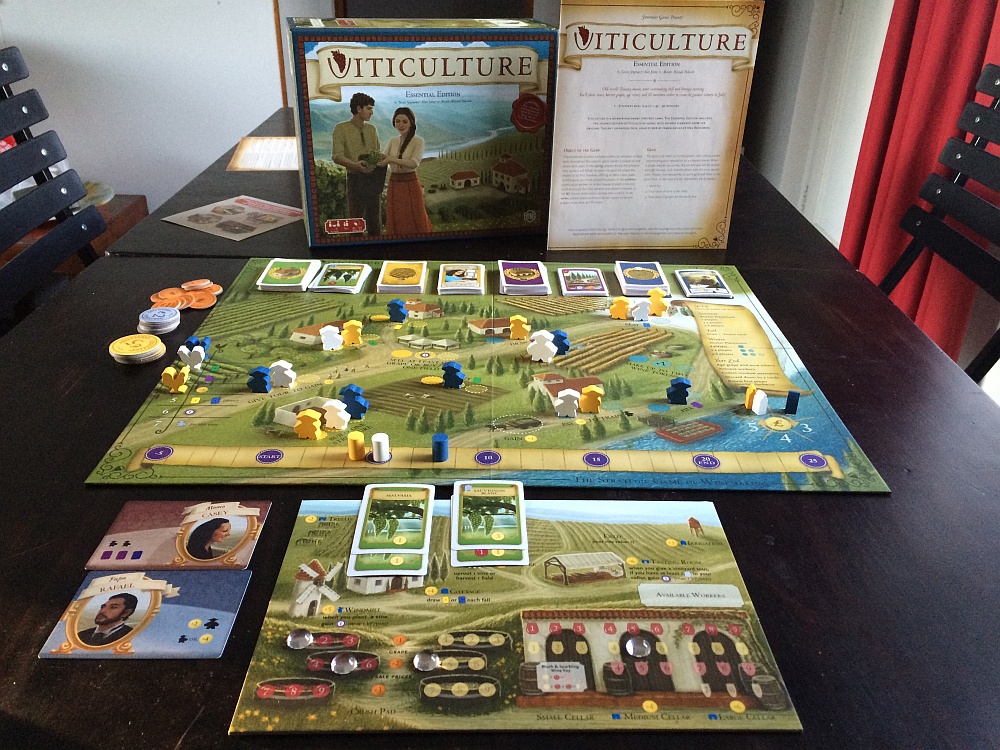
What is it? Viticulture, much like its theme, has matured and aged well since the original was picked from the minds at Stonemaier games. With some updated components, tweaks to rules and additional expansions from Tuscany blended into the cask; Is Viticulture: Essential Edition going to win accolades when being tasted by the Cardboard Quest panel of judges or leave a sour taste on the palate?
Growing up, I’ve had a memorable relationship with wine. From reading the labels of the bottles in my father’s modest collection, tasting my first sips of a smokey Shiraz through to visiting the wine route around Cape Town with friends, wine has been a constant companion and familiar comfort. It’s been an accompaniment to warm cozy fireplaces in winter, a fresh kiss of flavour with a summer salad and a “pop” to bring in the next year full of opportunities. So when Viticulture finally arrived in South Africa after a long wait, I was bursting to pour the components on the table and get a taste of its worker placement mechanics.
You’ve inherited a vineyard in the beautiful and scenic Tuscany region of Italy. While your land is primed for some of the finest cultivars, you’ll need to develop your Vineyard to be able to grow grape vines, recruit specialists to help your business grow, harvest the vines and bottle the grapes all in time to fill the orders of demanding distributors. You’ll need more workers, better infrastructure and some shrewd business choices if you want to be the most successful vineyard in the region.
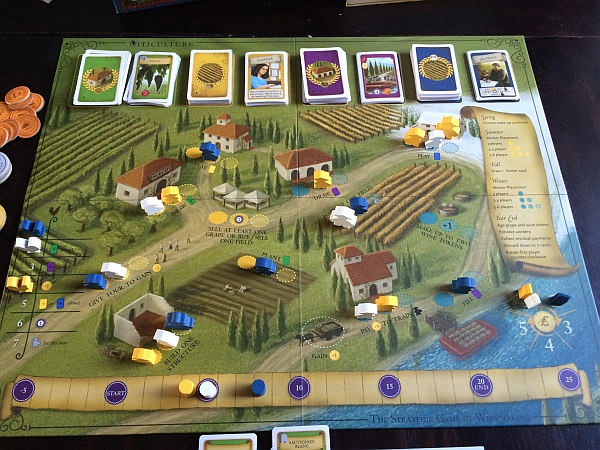
All of this estate is yours, with Summer Actions taken in yellow on the left side of the board and Winter actions in blue on the right.
In Viticulture, you’ll need to conduct your farming activities throughout the 4 seasons of each year to be a successful vineyard, placing your workers on various limited spaces in order to take the actions you’ll need. You’ll begin the game with a small wine cellar, fields to plant vines, crushing pads, 3 workers and some money bequeathed to you in the form of an inheritance. Over each of the 4 seasons, you’ll need to make crucial decisions as to the actions you’ll take with your workers, as they’ll only work in one season that year.
In Spring, starting with the first player, you’ll decide what time you want your workers to report for duty in the vineyard from the 7 time slots available. Waking up earliest will give you first choice of the seasonal actions throughout the year, but waking up later can grant you additional bonuses such as additional cards, money, victory points or even a bonus worker for the year. Balancing your need for bonus actions with first choice in activities creates meaningful decisions for players as a bonus can sometimes supersede early actions benefits depending on the game state.
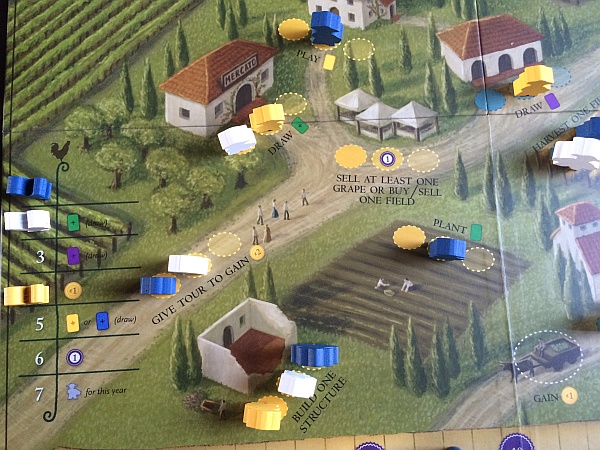
You’ll need to wake up early to get to the prime spots, but do you really want to pass up that extra green, purple or yellow card?
Once wake up order has been decided, Summer offers players the opportunities to sow the seeds for a fruitful harvest. In that order, players will place a worker on one of the 6 summer actions which include the drawing of vine cards, giving vineyard tours to accumulate finances, selling off of grapes or fields, planting of vineyard cards in your fields, utilising specialist summer visitor cards for special actions and building vineyard infrastructure. To plant certain cultivars, you’ll require irrigation and trellis structures to be built and to entertain additional guests you’ll require cottage accommodation to be constructed that allows extra visitors throughout the year. Building a tasting room grants victory points for offering tours guests wines from your cellar and windmills will do the same when you plant your first vines of the year. Need to harvest urgently? Then you’ll need a yoke and if you’re wanting to produce higher quality wines, you’ll be needing to build larger cellars to accommodate blush and sparkling wines.
As the summer sun sets, you’ll each draw an additional visitor card of your choice and reminisce on the success of the warmth of your vineyards and the success of your tourist trade while you prepare your winter activities.

Green Cards give you vines to plant, yellow and blue are summer and winter visitors respectively who will give you a hand and purple are order requirements for distributors needing certain quality wines.
While winter does not bring in an abundance of visitors, it’s the time for you to use your remaining worker actions (in wake up order again) to harvest grapes, collect potential wine orders from distributors, convert your grapes harvested into the crush pads into wines, train additional workers for more actions the following year, fulfil orders for victory points, and welcome winter visitors that will grant bonus actions to give your vineyard a boost in strategic areas. After everyone has used their annual actions, you’ll retrieve your workers from the board and collect any income residual income from fulfilled orders before starting the planning for next years harvest and activities.
Players will continue to tend to their vineyards year after year until one player has accrued more than 20 victory points and at the end of that year, the player with the most victory points will be awarded the gold medal for the most successful vineyard in Tuscany.
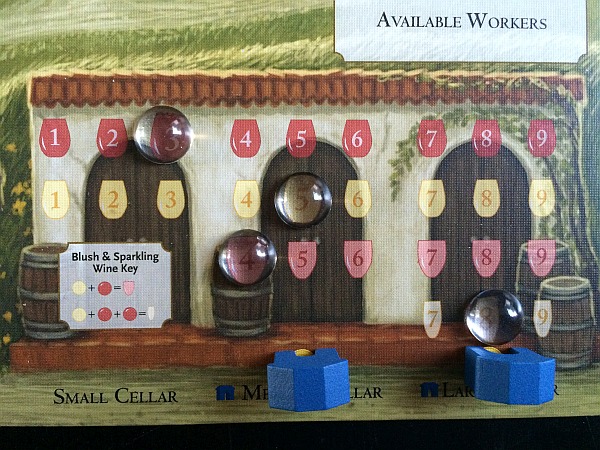
You’ll need to combine the right grapes from your crush pads to produce crisp whites, deep reds, tangy blushes and popping sparkling wines.
While this description lays bare the basic mechanics of Viticulture, it’s the intricate flavour, bouquet and lingering taste of each game that has me intoxicated. Much like any great Euro game there are multiple paths to victory, many options to uncover and a mesmerizing journey as you sit afterwards, your taste-buds thick with the memory of ambrosial nectar, yearning for the next glass.
In a 3 or more player game, each action on the board offers a bonus action, often doubling the reward of the action or giving a noticeable benefit of resources or victory points. To get these options you’ll need to sacrifice the initial benefits of waking up later to receive valuable resources, but you’ll still receive a bonus action of one of the 6 actions available in summer or winter. All these actions are constrained to limited spaces for workers (two spots per action in a four player game) so if more than 2 of you want to plant this year you’re out of luck… or are you? Each player gets a “grande” worker, who is simply a little larger than the rest. His bonus, you can take any action in that season regardless of whether all the spaces have already been filled with other workers. It’s a minor reprieve in a game that can really become quite cut-throat at the even number player counts.
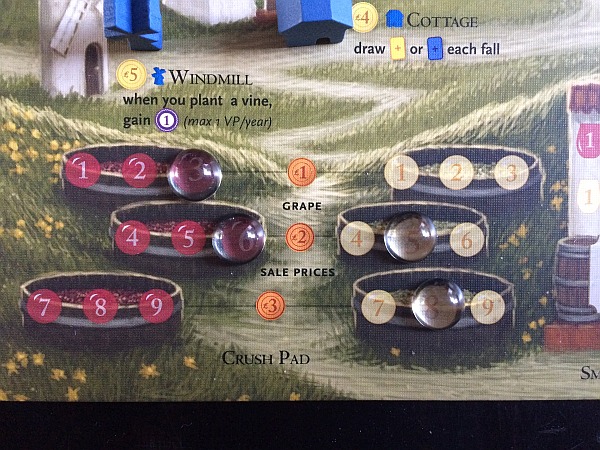
Sure you can stomp grapes… and let them mature here every year or simply bottle that special blend to send to the USA.
It’s the variety of equally appealing strategies in Viticulture that make it one of my favourite worker placement titles. Paying for vineyard infrastructure early allows you to plant the higher value grapes, which in turn will mature in to higher value wines which are needed for well paying distributor orders, but should you instead focus on training workers early to have more actions which surely will lead you to victory? Having expensive tasting rooms and wines in the cellar as well as a windmill will grant you two bonus victory points every year for simply running tours and planting vines, however building cottages early will give you extra bonus visitor cards, some of which can not only grant you additional paths to victory but also impedes your opponents success. Compete with others for a similar winning formula and you’ll struggle for spaces, but trying to stray too far from objectives and you’ll fall behind. Viticulture does an excellent job of keeping players neck and neck on the score track, leaving a satisfying finish on the players tongue. You’ll want to clean the slate, to start the game again and make subtle changes to your special maturing method for the perfect cask.
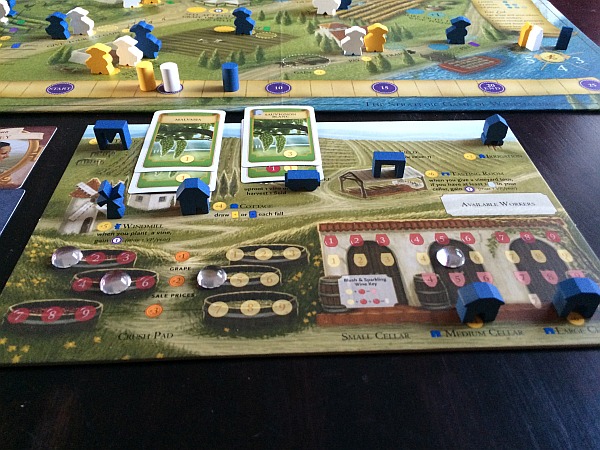
Beautiful wooden pieces depict your private structure of cellars, yokes, windmills and tasting rooms.
While characterised as a medium weight Euro, Viticulture has numerous flavours all competing for your attention which can be overwhelming for a player who hasn’t tasted many Euro board games before. I found with newer players that it could quite easily become overwhelming, with pivoting strategies becoming crucial and long term planning over the year being decidedly important for the vines to sweat fruit for the harvest. Visitor cards can also be game changing or lacklustre initially, depending on what the players current board state is, with some requiring wine in cellars, grapes in crush pads and other established vineyard elements to become valuable assets. While minor quibbles in my eyes, I have had new players mentioning these facets, however I’m sure many of them were simply the taste of sour grapes.
Without drawing this out, Viticulture is easily a favourite in my collection. With its heady presentation of carved wooden irrigation towers and trellis pieces complemented by the soothing rural art, it’s not only a deep and rich Euro, but a beautiful table piece for anyone playing. With rich depth that makes for close finishes each game and a satisfying experience for most at the table, I can wholeheartedly recommend that this goes into the collection of anyone with a taste for strategy board games. Just make sure that you have a well matured vintage to complete the years of refinement that Stonemaier Games has put into this title. Without a doubt, the Tuscany expansion has just become a “must-buy”.

Pros:
- Great Unique Theme
- Beautiful Presentation
- Well Balanced & Refined Euro Game
- Caters for Solo – 6 Players
Cons:
- Can Be Overwhelming to Novice Gamers
- Better at Even Numbers
-
kurisu
-
Ben Lambert
-
Stuart McGarrick
-




